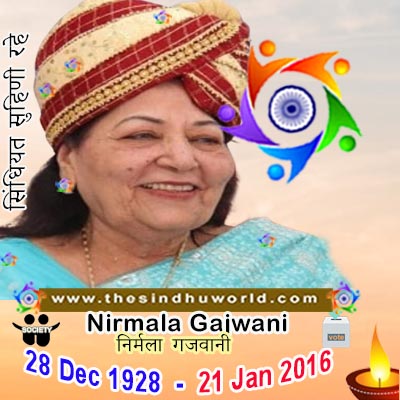Nirmala Gajwani
TSW Citation

This is even hard to imagine the pains of much younger mother just of 19 years of age with 10-month-old son in her lap facing the problem of uncertain future even not assured for a shelter. Be assured I am not writing a script for any Hindi film this the reality happens with famous social worker Nirmala Gajwani in the year 1947, historic but most troublesome year for the Sindhis, Punjabis and Hindus living in Sindh and adjoining areas of undivided India as due to partition these parts were going to form new country Pakistan.
About Nirmala Gajwani
This was not just being deprived of wealth of generation but was the situation of being uprooted with immense pressures for finding new suitable earth for getting rooted once again and grow to touch the lost kingly status. The only satisfying thing for her was doctor husband.
Nirmala was born on 28th December 1928 at Rohari Sindh in Kewlani family. Early marriage with Dr. Hasanand Gajwani proved hurdle for her education and she left the academics while was in the first-year graduation in Arts. Pains and sufferings of partition resulted in creating a desire for social work, especially for making the women self-sufficient. These were the days when on advice of Mahatma Gandhi, Maharaja of Kutch agreed to give land for the resettlement of Sindhis forced to migrate. [the land where present towns of Adipur, Gandhi Dham and Kandla free port are developed.]
In the year 1952, Dr. Hasanand Gajwani who joined the government service after partition was transferred to remote areas of Bachau Taluka and this was the start of journey of Sindhi woman in time. The area was too remote and literacy rate not in females but even in the males was not even to be called the satisfactory one. This was a ready to use ground for being active in social life and Dadi [elder sister] Nirmala utilized this. There were hurdles not only at social levels but also on the economic fronts.
This was her dedication and untiring efforts that slowly and gradually social opposition for her efforts of making the women literate and skilled started to vanish. To face the financial problems innovative mind of her proved helpful as she finds World Health Organization and central Social Welfare Board [Delhi] to support her projects financially. This was token of recognition of her efforts that she was elected unopposed for being the President of Kutch Educational Board.
After being elected from Anjar (Kutch) Vidhan Sabha Constituency with huge popularity votes in 1967 for Gujrat state assembly, she was selected as Deputy Speaker of the house. Kandla Free Trade Zone and Indian fertilizer cooperative are the symbols for her dedication towards the care and progress of the people of area. During the times of spilt in congress she left the politics and return back to concentrate on her social works at Adipur and Gandhi Dham. She is the only person from the Kutch area to receive Best social worker Award [1975] from the Central Social Welfare Board.
During the 1980 – 1990 she was the instrumental hand for the establishment of Sadhu Vaswani International school. she is also the force behind the construction of Working Women Hostel at Gandhi Dham on the land expanded to about 2 acres area. Her success attributes lie a much supportive husband, dynamic personality, tactful dealing, humorous nature, transparent heart and true hard work.
She respires last on 21 January 2016 in Rajkot.
Famous and popular Sindhi folk singer Bhagwanti Navani is eventually immortal as she even after losing the physical existence still alive at hearts of thousands and thousands of Sindhi music lovers. Often called as Sindhi Koyel Bhagwanti was born on 01 Feb 1940 at Nasarpur. Undisputed queen of Singing Sindhi Lada (marriage ritual songs) Bhagwanti will always be remembered for singing Sukhamani Sahib (Guru Bani) in Sindhi. She also acted in Sindhi film Sindhua Je Kinare. On 22 Oct 1986 she left for heavenly abode.
